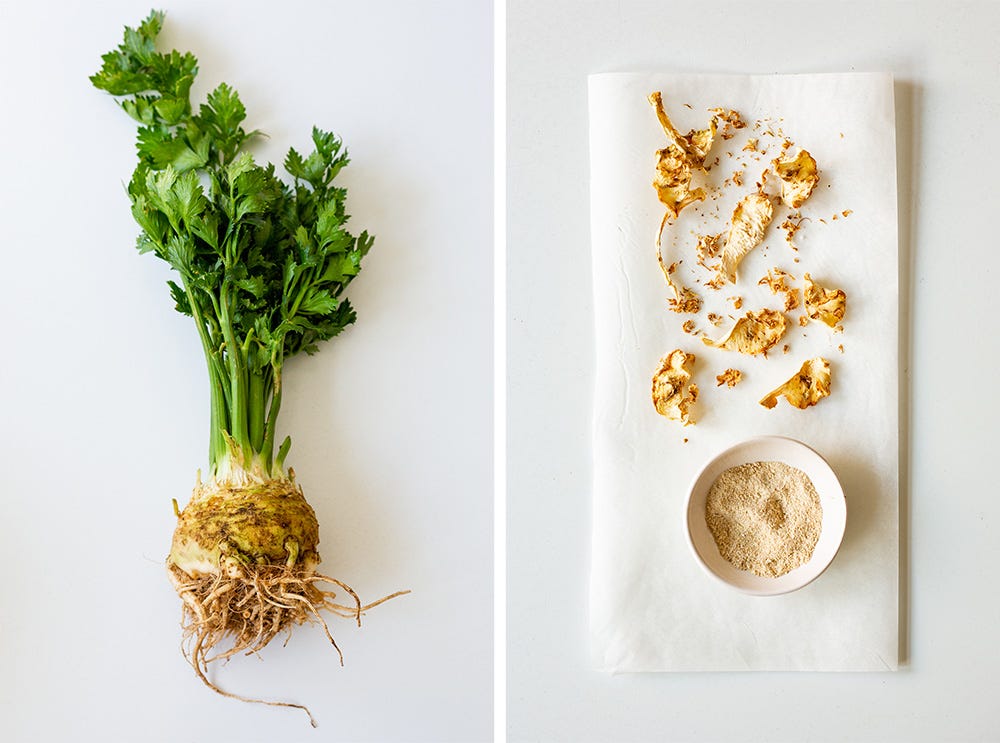Although this covers making celery salt and veggie broth, it might also be called cooking with what’s left on the chopping board – or getting to know celeriac.
These two elements form part of next week’s reveal so start saving plenty of vegetable peelings in the meantime. (More on that below.)
Celery salt is useful to have on hand – not least for sprinkling over Bloody Marys! – and is usually a mix of salt and ground celery seeds, but we use celeriac.
What exactly is celeriac?
Celeriac is also called celery root and although it looks like a root, it’s a corm – an underground part of the stem that acts like a plant pantry. It makes sense as you can see the roots coming off the base of the rounded corm in the picture above.
Peeling back the thick layer of ‘warty’ skin (as food writer Stephanie Alexander describes it) reveals a creamy coloured vegetable. And while this variety of celery may look rougher when unpeeled, it is more delicate in flavour.
It lends sweetness when boiled and mashed with potato (excellent with braised beef short ribs) and crunch when raw, cut into matchstick lengths and mixed with homemade mayonnaise and a good dollop of Dijon mustard as remoulade.
Mostly it reminds me of German Suppengrün or Suppengemüse, a bundle of vegetables secured with a rubber band and sold at markets. Strapped in along with the wedge of celeriac is parsley, parsley root (or parsnip), carrots, and a leek.
It’s like a German take on soffritto or mirepoix (onion, celery, carrot), the aromatic base from which to build broth, soup, or stew – but with onion’s Allium relative, the leek, and celery’s kissing cousin, celeriac, represented instead.
The celery salt
Salt and celery have a natural affinity since the green ribs do have something of a saline taste and it’s at home growing in damp environments close to the sea.
Stephanie advises1 it’s worth saving the peels when preparing (washed) celeriac, as this relative of the celery stick can be turned into seasoning too.
To make, spread the peels on a baking sheet and place in the middle rack of the oven, using the residual heat after baking or roasting, to dry them out overnight.
Once the celeriac peelings are fully dry, combine with sea salt, and blend to a powder in a clean spice or coffee grinder.
We use one tablespoon of dried celeriac peels to every half teaspoon sea salt.
The veggie broth
The foundation of this broth is onion skins – that’s how it gets such a deep, rich colour. Follow the link below, start collecting all the vegetable bits and bobs, seal in airtight containers, and freeze until you’re ready to make the broth.
In Brandon’s words, a basic vegetable broth is just a very diluted soffritto, so take your cue from that or the Suppengrün. Save carrot peelings, the heart and leaves of a bunch of celery, some parsley, perhaps a leek – and, of course, the onion skins.
This is the third in a series of posts about salt, seasoning, and creating satisfying flavour, brought to you with a pinch of nostalgia and plenty of love for the women who raised us.
To catch up on the other posts, click on the links below.
For Brandon’s essay on what salt to use and how to use it, click here
For Nikki’s essay on salt, water, and seasoning soup, click here
Veggie broth
In essence, the idea is to save vegetable peelings and ends and use them to make delicious broths ‘for free’. We started doing this while locked down at home in 2020, and at a time when we were thinking about frugality, excess, and our planetary footprint, it seemed like an excellent idea. The very first time we tried it, we were wowed by what could be …
The Cook’s Companion by Stephanie Alexander (Australia: Penguin, 2004)




